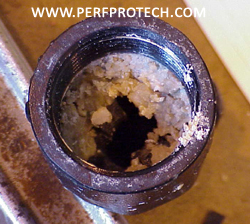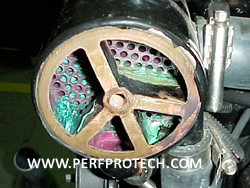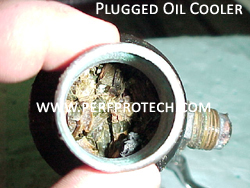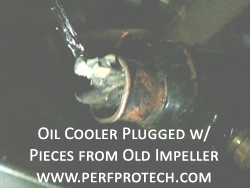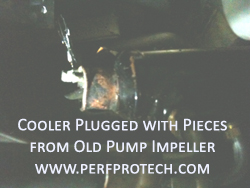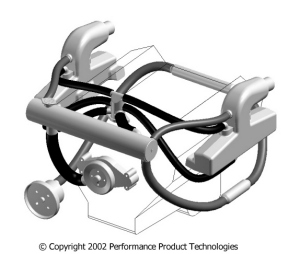Closed Cooling System – Tip’s
**WARNING – Make certain that the fresh water cooling system is not hot before removing the pressure cap. These systems normally operate with hot fluid under pressure. Injuries can result in carelessly removing the cap of a hot system**
FRESH WATER COOLING SYSTEMS – GENERAL TROUBLE SHOOTING
Temperature Problems
1. Before spending too much time chasing a temperature related problem, make certain the gauge is functioning properly by checking the gauge against a known good thermometer. Many inboard & I/O marine temperature sending units are the same basic devices produced for automotive applications. Since automotive engines normally operate at temperatures higher than marine engines, these devices can sometimes provide inaccurate readings. Bad gauges are one of the most common causes of problems. In our opinion no boater should be without an IR-Thermometer on board the boat at all times. You can shoot the temperature of the thermostat housing which should tell you whether the temperature that the gauge on the dash is reading is accurate or not.

2. Normal marine fresh water cooling systems allow the engine to operate at temperatures moderately above 160 degrees F. However, as the heat exchanger accumulates time the system may begin to operate in the range of 170 degrees F. NOTE – In most marine cooling systems a normally functioning system should never allow the engine to operate at temperatures in excess of 180 degrees F.
Thermostats
1. Marine engines utilize special thermostats specifically design to function in fresh water cooling systems. Although many people replace their marine thermostat with automotive replacements, in many cases they are subjecting their engine to conditions which will cause long term damage. In many cases this damage will not show up for a period of time, and do so in ways that appear unrelated to the cooling system.
2. Overcooling – Since the fresh water cooling system generally utilizes a heat exchanger designed for a particular application, the heat exchanger has been designed with a certain amount of capacity. This includes excess capacity to account for normal system degradation. Therefore, it is generally simple to identify overcooling related problems. These types of problems will almost always be thermostat related, usually an improper thermostat being used or something lodged in the thermostat and not allowing it to close properly.
3. Overheating – These types of problems can be more difficult to identify but in many cases related to a malfunctioning thermostat. Verify that the thermostat functions properly by inserting the thermostat into a pot of boiling water. Most thermostats will have the opening temperature stamped somewhere on the part, and should reach full stroke at approximately 20 degrees above the opening temperature. Thermostats are not repairable and should be replaced with the manufacturers specified part as these are system specific components.
Raw Water Pumps
1. Most fresh water cooling systems are designed with raw water pumps that provide approximately 30 – 35 gallons per minute (gpm) of water flow. Therefore, for a full fresh water cooling system (including the engine heat load as well as the exhaust system) the general temperature rise for the raw water will be approximately 50 degrees F. This means that if you were operating in 80 degree F water conditions, the water temperature exiting the heat exchanger and entering the exhaust risers should be in the range of 130 degrees F. The normal temperature tolerable to the touch is 140 degrees F. Therefore, if the proper amount of raw water is being delivered, the exhaust risers should feel hot to the touch, but tolerable.
2. Most sea water pumps used today utilize a flexible rubber impeller. While these types of impellers do a very good job at producing flow while tolerating a certain amount of debris, they are extremely susceptible to heat related dry run failures. While the Mercruiser style composite bodied water pump was very good at resisting corrosion, it lacked much in dry run capacity. This is due to the fact that composite materials do not dissipate heat nearly as well as metallic materials. To be on the safe side, an impeller should be changed at least every other season if not every season.
Step #3: Replace the Sea Water Pump Impeller (Watch “How To” Video)
Heat Exchangers
1. For most marine applications the tube and shell type of heat exchanger is used. However, larger commercial application will sometimes use a plate heat exchanger, but these are generally more expensive and very difficult to service.
2. In a tube & shell heat exchanger the raw water passes through the inside of the tubes, while the ethylene glycol passes on the outside of the tubes. Most generally the raw water side of the unit will allow for several water passes as increasing water velocities also increases heat transfer efficiencies. The glycol portion sometimes referred to as the shell side, generally allows for a single pass but has baffles to force the coolant flow upwards and downwards in an effort to also increase heat transfer.
3. One of the difficulties facing the marine cooling system, or any cooling system for that matter is in separating the air from the coolant. Air is a very poor conductor of temperature and therefore will force a cooling system to overheat almost immediately if a significant amount is contained within the fluid. Most original equipment heat exchangers now utilize a separation chamber to allow for the air to be separated from the fluid and then purged to the overflow bottle. Some marine engine manufacturers, and most automotive manufacturers now utilize a pressurized system which separates the air from the fluid and retains it in a structural designed reservoir. The main advantage of this design is the ability to service the system and allow for the highest level of system efficiency since it will constantly separate air from the fluid, not just when the engine is shut down and cooled (thermal-cycled).
